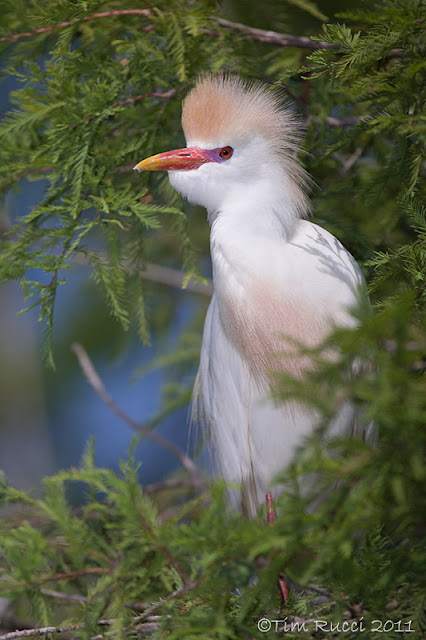Program notes: Click on any photo to see a larger version. Prints are available from a link to my web page posted at the bottom of this entry.
The story continues. I managed to get back down to the Cape for one last chance to see Space Shuttle Endeavour launch on it's final journey, and everything went fine with the shuttle lifting off on time at 8:56am Monday. I have just chocked one more item off my 'bucket list'.
On this visit, I was at the "turn basin" viewing site, which is a few hundred yards in front of the VAB Building, approximately 3 miles from the launch pad. This is the closest I've ever been to witness a shuttle launch. On previous outings, my best attempts had come from the NASA Causeway, which is about 6.5 to 7 miles south of the launch pad. One advantage viewing it from the turn basin is the smoke plume from the solid rocket boosters does not obstruct your view as it does from the Causeway.
Due to the low cloud cover, the shuttle was gone in just about 22 seconds from the time it lifted off. Usually I am able to follow it through my lens and photograph the solid rocket booster separation, which does not happen until well beyond 2 minutes into the flight. On this occasion, we could not see the shuttle at all after it ascended above the first cloud layer.
So this time it was over quickly. We arrived at around 5:30am and staked out a spot to shoot from within the relatively small area that was roped off for spectators, then we waited about 3.5 hours to view the launch. This launch was spectacular. It's much more exciting from this distance, and the ground felt almost like an earthquake as the loud rumble from the shuttle shook everything in sight. Light was not the best for photography, with the sun about 20 degrees to our right and up roughly 30 degrees off the horizon at launch time. But the low cloud cover actually helped a bit to cut down on the lens flare I had been seeing through the lens prior to when the clouds rolled in. At least we were not shooting into direct sunlight, which would have made it next to impossible to get any decent photos.

I owe a special note of thanks to Cindy's cousin,
David Turko who obtained the NASA pass and then invited us to join him and his sister Patty for the launch. We had a thoroughly enjoyable weekend which also included a boat cruise at sunset Sunday, when we took advantage of some fantastic soft light to do a photo shoot with David's better half, Liz. You may see some of those images in my nest post.
While waiting for the launch we visited with folks we met, and we monitored the light. As the conditions constantly changed we discussed camera settings in hopes that everyone would be able to get properly exposed photos. Exposures can be tricky, especially if one is used to shooting in aperture priority or shutter priority mode. I avoid those settings and shoot manual exposures so that the bright flame of the solid booster does not affect the metering of the camera, and therefore change the exposure. I have seen many people ruin photos by not taking this into account. For anyone who may have been unfortunate it that regard, I have made prints available from a link at the bottom of this post.
During our wait we especially enjoyed meeting Alyson and 3 of her friends, who we learned all who work for the American Cancer Society. After I lifted my hat revealing my bald head, and told them I was fighting non-hodgkins lymphoma, we ended up having a lot to talk about, and they were all very helpful and supportive.
I am disappointed that the shuttle program is coming to a close, and there is no other program ready yet to go behind it. This is also going to be devastating to the central Florida economy as all the NASA employees begin to loose their jobs over the next month or two.
I cannot help but believe there is enough fat and waste in our federal budget that could be cut in order to provide funding for projects such as NASA. Our space program over the years has resulted in many discoveries and innovations that have led to scores of products we use in our every day lives, such as teflon used to make cookware, and many, many others. It is a shame that a program that has been so vital to us is now dying due to lack of funding and what I believe are misguided priorities.
A larger variety of photos of this launch can also be seen on my main web page here:





























